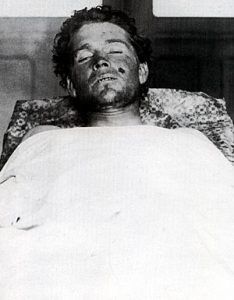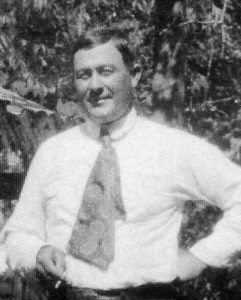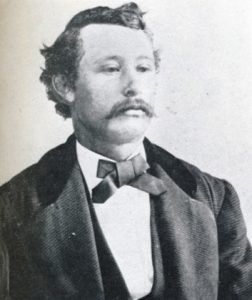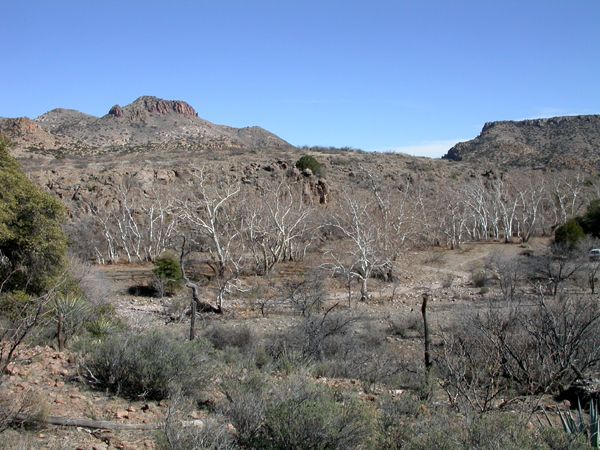Also referred to as the Christian Gang, led by “Black Jack” Will Christian and his brother, Bob, from Oklahoma, the gang operated in New Mexico and Arizona after the Christian brothers killed two lawmen and escaped from an Oklahoma jail in 1895.
The charter members of the gang were:
- Will Christian, aka Black Jack, 202, Frank Williams
- Robert “Bob” Christian, aka Tom Anderson
- Bob Hayes, aka John West, Sam Hassells
- George Musgrave, aka Jeff Davis, Bill Johnson, Jess Johnson, Jesse Miller, Bob Steward, Jesse Williams
- Code (or Cole) Young, aka Cole Estes, Bob Harris
In 1896 and 1897, the gang rustled cattle and robbed stores, banks, trains, and stagecoaches.
In New Mexico, George Musgrave, Bob Hayes, and Code Young were all working as cowboys on ranches near Roswell, New Mexico when, after a while, the three drifted on down the line, taking jobs in southeastern Arizona Territory where they met Black Jack Christian and his brother Bob. With all having outlaw inclinations, the men soon formed the High Fives Gang, named after a popular card game of the time.
Musgrave appears to have been the magnet that attracted all five men into the gang. Though there was no true leader of the band, and they frequently split up before conducting their many crimes, journalists soon focused on the handle “Black Jack,” and it was quickly assumed that Will Christian was the leader.
The first crime they were known to have committed together occurred on the evening of July 20, 1896, when they rode into Separ, New Mexico, the site of a cattle-loading station on the Southern Pacific Railroad line. They soon made their way to John D. Weems’ general store, which also housed the post office. While Bob Christian and Bob Hayes stayed outside with the horses, serving as lookouts, George Musgrave, Code Young, and Black Jack pulled bandannas up over their faces and walked inside with their six shooters drawn. From the post office, they netted $20.94, and from the store, $180 plus about $100 in supplies. In the Bootheel country, the five men then hightailed it south for Hachita.
On August 6, 1896, the High Fives Gang attempted to rob the International Bank in Nogales, Arizona. Bob Christian and Code Young remained outside with the horses while Bob Hayes, George Musgrave, and Will “Black Jack” Christian entered the bank. However, it didn’t go as planned. Once inside the bank, Will Christian pointed his gun at the cashier while Musgrave circled the counter and held the bank president at gunpoint. As the cashier stuffed the money into the bag that Black Jack had given him, the bank president suddenly made a break for the door, and in the confusion, the cashier grabbed his pistol from beneath the counter and shot Musgrave in the knee. In the meantime, Black Jack Christian retrieved the money bag but dropped it as he ran through the front door. While the robbery was in progress, a newspaperman named Frank King spotted the bandits and opened fire with a .41 Colt. Though he missed the outlaws, he hit two of their horses as the gang galloped out of town.
Soon, a posse was on their tail by a posse led by Deputy Sheriff Bob Leatherwood of Tucson. The officers caught up with Bob Christian, Code Young, and Bob Hayes near Skeleton Canyon, which straddles the modern-day Arizona and New Mexico state line, on August 12, 1896. The outlaws turned on their pursuers, and a sharp fight erupted, in which Deputy Frank Robson was killed. The gang then fled, slipping across the border into Sonora, near the San Antonio Pass in the Patagonia Mountains.
Meanwhile, Black Jack and George Musgrave, who had avoided Skeleton Canyon, hid somewhere in San Simon Valley. Not content to sit still for long, the pair soon resorted to robbing a store owner at Bowie Station of two brand-new pairs of boots.
While the gang was on the run, the U.S. District Court’s grand jury in Silver City, New Mexico, criminally indicted for their earlier Separ robbery because it included the robbery of the U.S. Postmaster, a federal violation.
Next, the gang made their way to Rio Puerco, New Mexico, about 30 miles southwest of Albuquerque, where they intended to rob the eastbound Atlantic and Pacific train on the night of October 2, 1896. Concealing themselves by the water tank, they were waiting when the train made a brief stop to attend to an overheated crank pin. As the train started forward again, three of the outlaws drew their pistols, aimed them at engineer Charles Ross and fireman Abe Reed, and ordered them to start the train again. A shot was then fired, which struck the brakeman’s lantern and a second shot put out the light. Engineer Ross was then marched back to uncouple the Express Car. Unfortunately, one of the passengers aboard the train was none other than U.S. Deputy Marshal Will Loomis, who was returning from serving subpoenas in Gallup, New Mexico. After hearing the shots, he went to investigate.

Code (or Cole) Young, aka: Cole Estes, Bob Harris, Tom Harris
While the engineer was working on uncoupling the Express Car, Loomis approached from the rear and fired upon the robbers, killing Code Young. The rest of the bandits immediately fled. Ironically, Loomis had been chasing the gang since mid-August, having followed their trail from Santa Fe via Deming to Skeleton Canyon and Mexico.
With lawmen hot on their trail again, the gang held up the San Antonio-to-White Oaks stage line near White Oaks in Lincoln County, New Mexico, on October 7. They successfully made off with $500 and exchanged their horses for those of the stagecoach. Encouraged by their holdup, the gang stopped the westbound stagecoach about six hours later but this time made off with only $32.60.
A short time later, Bob Hayes and Black Jack Christian traveled with George Musgrove to settle a score George had with a former Texas Ranger named George Parker. They rode to the Circle Diamond roundup camp on the Rio Feliz on October 19, where Musgrove shot Parker dead.
Two days later, on October 21, the men robbed the White Oaks stage twice in one day. They first hit the westbound stagecoach from White Oaks to San Antonio at a little past 8:00 p.m. near Cavanuagh’s Lake in the Oscura Mountains making off with about $160. They hit the eastbound stage two hours later.
For four months, the activities of the High Five Gang had baffled law enforcement in Arizona and New Mexico with their many chases resulting in netting one outlaw — Code Young. As a result, New Mexico’s Marshal Edward L. Hall announced rewards of $500 for the arrest and conviction of any of the robbers.
On November 18, 1896, a posse caught up with the men at the Diamond A Ranch in the San Simon Valley of southwest New Mexico. Lawman Fred Higgins killed Bob Hayes in the inevitable gunfight that ensued.

George West Musgrave
In the meantime, Black Jack Christian and George Musgrove escaped.
On the night of March 22, 1897, Black Jack and George Musgrave showed up at Cliff, New Mexico, about 25 miles northwest of Silver City. Storming into the town’s general store, which included a post office, they took $201.70, the proprietor’s gold watch, clothing, boots, several knives, and a six-shooter.
With lawmen still on their trail, the fugitives were tracked to a cave near Clifton, Arizona, and yet another gunfight erupted. Christian was killed on April 27, 1897, but two others were able to flee.
Bob Christian surfaced in Mexico in the fall of 1897 and then dropped out of sight forever.
George Musgrave would be captured years later and tried for the murder of George Parker but was acquitted. He then fled to Paraguay, gaining fame as a leading Gringo cattle rustler. He lived until the age of 70 when he died of natural causes.
© Kathy Alexander/Legends of America, updated July 2022.
Also See:
Sources:
Alexander, Bob; Desert Desperados: Banditti of Southwestern New Mexico; Gila Books, 2006
Nash, Robert; Encyclopedia of Western Lawmen & Outlaws; De Capo Press; New York, NY, 1994.
Tanner, Karen and John D.; Last of the Old-Time Outlaws: The George West Musgrave Story, University of Oklahoma Press, 2002


